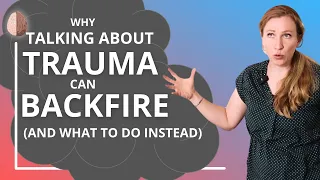Resilience is a skill that can be learned, and I was watching a creator who totally embodies it, Laura Kampf. She’s such a great example of someone who is resilient.
What It Means To Be Resilient
When it comes to being more resilient a lot of people probably think that being more resilient means “Just try harder” “Suck it up” “Get over it” or “Just push through”.
They think that the way to be more resilient, the way to overcome obstacles is to just force yourself to be motivated and keep going even if things aren’t working.
And, while grit is a great characteristic, just forcing it can’t be your only tool. If you really want to be more resilient, you’ve got to have a toolbox of skills to rely upon when it all hits the fan.
So in this video you’ll learn 6 ways to be more resilient. And I’m going to give you lots of examples of how to be resilient from Laura’s channel. Let’s get better at feeling.
How To Be Resilient
Before we get right into it, I just want to add something real quick (I love that BetterHelp let’s me do short integrations).
If you’re feeling overwhelmed with life, if you’re having a hard time dealing with all the stress and challenges you’re facing, working with a counselor might help you overcome those challenges.
BetterHelp makes it easy for you to connect with a licensed mental health professional from the comfort of your own home, check out the link in the description for 10% off your first month.
Now, let’s get back to how to be resilient. Resilience means to bounce back. So for example, rubber is resilient.
Resilience means getting back up just one time more than getting knocked down. I think some people think mental strength comes from just being super tough, super strong. But I would disagree. Ice is strong, but it’s not resilient. Resilience is a combination of toughness and flexibility.
It’s not just trying the same thing over and over again. It’s not just trying harder. It’s not just willpower. It’s trying something differently.
A Resilient Person Has A Growth Mindset
So that’s the first trait of resilient people: A belief that everything is “figure-out-able”, a growth mindset. An attitude that if I don’t have the skills now, I can learn them. That if I come across a problem that I don’t know how to solve, I will learn the skills to solve that problem.
In her latest series, Laura is trying to renovate a house, a really old house. A really old house with water damaged walls, and all sorts of unexpected problems. And Laura is not a contractor, she’s never renovated a house before, she’s a maker and designer. And she thought the house was pretty solid before they started the renovation. So as she starts coming across problems that are much bigger than her ability to solve, at first she feels overwhelmed and discouraged, but then she uses her resilient mindset and says “We’ll figure it out.”
Resilient people see every problem they face as an opportunity to learn a new skill and improve themselves.
Almost every time they come across a new, difficult, expensive problem with the house- like finding out there’s electrical wiring behind the shower or that there’s mold or asbestos or a beam is rotting, she says ”Well, it’s good we learned about this problem because now we can fix it.”
Because she has a growth mindset, Every time Laura comes across a new problem she researches it, she finds out the names for things, and she explores what the solution is.
I saw this recently with one of my clients. I mentioned to her that the process she was going through of learning to be kinder to herself could be called “reparenting.” As soon as she had a word for it, she started listening to podcasts and reading articles on the topic. And that helped her make a ton of progress both in her parenting and in herself.
Resilient people, when they come across a problem in their relationships or their emotions or mental health- they ask- what skill am I missing? What can I learn to resolve this?
A Resilient Person Is Not Afraid To Ask For Help
And that leads us to the second trait of resilient people. They don’t try to do everything alone. They don’t pretend to be self-sufficient. They build a team, they reach out for support, they ask for help. This may be seen as a sign of weakness to some people but it’s actually a trait of resilient people. Laura hired a photographer, she reached out to her community for suggestions, and she found some experts in her field to help her. When things get hard, she reaches out even more. This takes a lot of vulnerability, especially on the internet.
With mental health, shame prevents a lot of people from reaching out. Struggling with depression- Shame says don’t tell anyone. History of trauma? Hide that from people. Having difficulties in your marriage- pretend like everything’s fine. You may look strong on the outside, but not seeking help actually makes you more fragile, not resilient. It’s super hard for me to ask for help but in the last year I’ve been forced to, and I’ve seen wonderful results. Resilient people replace shame with vulnerability and connection.
A Resilient Knows How To Tolerate Uncomfortable Emotions
The next trait of resilient people is that they have skills for tolerating uncomfortable emotions. Laura finds out that all the beams in her house have been damaged by ants. Laura gets overwhelmed, stressed out, worried. But she doesn’t feel ashamed to have normal emotions. She just works through them. She often doesn’t know what to do next to solve the problems with her house and they get increasingly more expensive. So She takes breaks . She sleeps on it. She works on a different project for a while. She takes a vacation and comes back with a fresh approach. She eats ice cream and other yummy food with friends and she pets her dog. She must be under a lot of pressure but she has faith that she can work through the problems and she takes a sustainable approach to solving problems instead of sprinting about in a panic about everything that’s a catastrophe. She has developed the skills to tolerate uncomfortable emotions.
A Resilient Person Focuses On What Can Be Controlled
The next trait of resilient people is that they learn to focus on what they can control instead of what’s out of their control. She needs a place to live while she works on her big house, so she has a tiny house side project. And things didn’t go perfectly with that either. She can’t stop the rain from having ruined her tiny house, but she can move it under a shelter and make repairs. She can’t fix the dry rot in the beams but she can learn how to replace them
In a 2005 study on resilience, researchers said “Depression is hopelessness and helplessness and so resilience is the opposite.” Resilience is accepting what you can’t change and focusing your energy and attention on what you can change.
“You’re not helpless, you do have control over many aspects of your life.” A simple way to develop this skill is to frequently do the Locus of Control activity.
A Resilient Person Knows How To Be Flexible
Flexibility: Resilient people learn to be flexible in their thinking and adaptive to changing situations. They develop the ability to adjust their strategies and tactics in order to find solutions. Albert Einstein said “Insanity is trying the same thing over and over and expecting different results” If your only tool is a hammer-every problem looks like a nail.
Super rigid thinking can actually contribute to mental illness, but flexible thinking can be very resilient.
People who struggle with mental health may try the same thing over and over-
-make a mistake beat yourself up- over and over
-Struggle in a relationship- be submissive instead of assertive, over and over
-Feel anxious about a social situation, avoid it over and over
One of the biggest things I’ve learned as a therapist is that there’s dozens of things you can try for every problem you face. I’ve got an entire toolbox for anxiety – willingness, diffusion, acceptance, mindfulness, grounding skills, deep breathing, cognitive treatments, nutritional treatments, sleep treatments, medication, relational skills, and on and on.
Resilient people are able to identify problems and develop creative solutions in order to move forward. They are not afraid to take risks and are willing to try new things.
So resilient people just keep experimenting with new approaches, they try to solve a problem from a different angle and they practice accepting failure as just being part of the process. No one likes failure, but you can learn to be good at tolerating it.
(6)OK, the 6th thing that resilient people practice is one of my favorite traits that Laura has,
She laughs. When things are bad. She laughs. Sometimes there’s nothing else she can do.
Marjorie Pay Hinckley said “The only way to get through life is to laugh your way through it. You either have to laugh or cry. I prefer to laugh. Crying gives me a headache.”
So there you have it. 6 ways to be more resilient
- Have a growth mindset. Every challenge is figure-out-able and an opportunity to learn and improve.
- Replace shame with connection- reach out for support and build a support network
- Develop skills for regulating uncomfortable emotions- take breaks, do some self-care
- Focus on what you can control, let go of what you can’t
- Be flexible and try new things
- Laugh
I hope you found this helpful, Laura if you see this- I hope you agree!
Check out our course below to rewire your brain to be more resilient.





